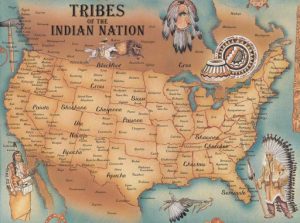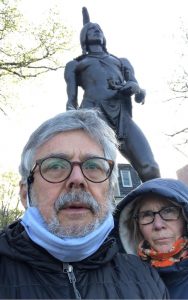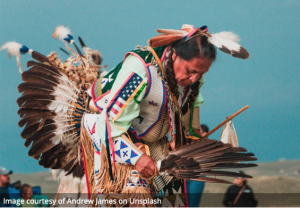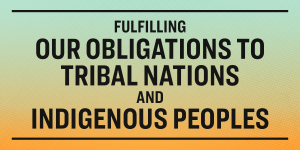REPARATION PLEDGE MAY 5 AT
MASSASOIT STATUE IN PLYMOUTH
The Native Land Reparation Pledge is a solemn pact one makes with their conscience and is not legally binding. It is a conscientious promise to be fulfilled if the conditions in one’s life permit.
Why We Pledged 1% of the Sale Price of Our Home to a Native Tribe
Making the decision to pledge 1% of the sale price of our home, when sold in the future, is based on our coming to terms with the awareness that:
- The land we live on embodies the spirit of the Mashpee Wampanoag Tribe.
- Members of the tribe who thrived on this land for 12,000 years were nearly exterminated by advancing European settlers.
- The indigenous people treated the land as sacred and as their relatives (the water, the air, the soil, the animals) not as expendable commodities for profit.
- The inherent spiritual value of the land our home is on is increased immeasurably once it is understood that it belongs essentially to Mother Earth.
- The result of settler colonization has led to subjugation and poverty for indigenous people.
- The displacement of native tribes has led to high suicide rates among its youth.
- The marginalization of indigenous people has left many dispirited, dejected, and strangers in their own land.
- The concept of monetary ownership of one’s home blinds us to our moral obligation to share with those whose ancestors were once stewards of the land we live on.
We made this pledge with a sense of duty that comes with taking to heart the points of awareness listed above (the complete list is endless). What is clear is that if we were to resist the calling to take this action, we would not be able to live with ourselves.
Lewis and Meg McGuire Randa
Duxbury, Massachusetts
Mashpee Wampanoag Territory

We could not, in good conscience,
do otherwise.
NEW NATIVE LAND REPARATION
—-> WEBSITE <—-
ACTING OUT OF CONSCIENCE
We want you to know the profound impact the Quaker-inspired Native Land Preservation Action has had on us. Because of the emphasis placed on our sacred alliance with the Mashpee Wampanoag Tribe (or local tribe in the area of the country where we reside), we have decided to take the next step in this sacred circle and include an expression of reparation as part of our involvement. We realize that reparation can take on many forms; below we describe what works best for us and might well work for others.
In an expression of our heightened awareness that the land we live on is ancestral tribal territory, we have decided as a matter of principle and as an act of conscience that we would embrace native reparation. Therefore, we shall donate, when our homes are sold one day, 1% of the sale price to a local native tribe or indigenous rights group. We do this in keeping with the spirit of the Native Land Preservation Action. Our prayer is that others throughout the ancestral land of native tribes in America might consider doing likewise.
Individual Signatories: Lewis and Meg Randa, Gail Melix and *James Noyes, Kathy Olsen, Sarah Marter, Mare Tomaski
Organizations: The Peace Abbey, The Life Experience School, Catholic Worker Houses of Des Moines, IA
LIST OF INDIGENOUS TRIBES
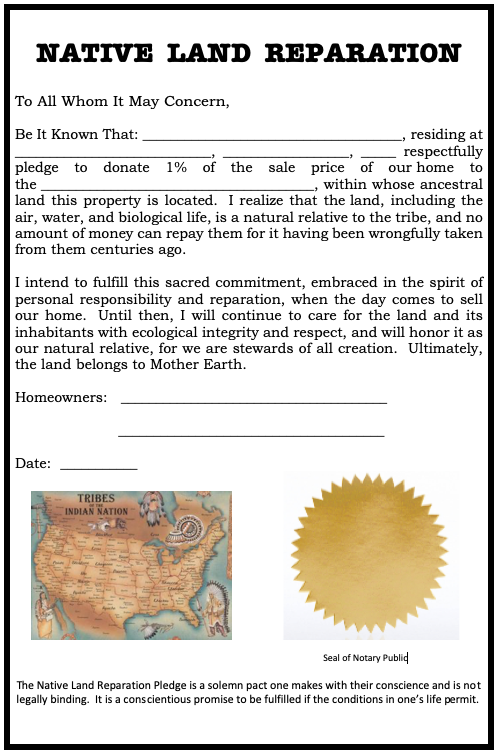
 Reparation Form
Reparation Form
The Native Land Preservation Action gave birth to a new expression of an old concept ~ native reparation. Meg and I were so touched by the Native Land Preservation Action that we were moved to embrace the concept of reparation and worked to write a Native Land Reparation Pledge. This pledge states that we intend to give 1% of the sale price of our home in Duxbury to the Mashpee Wampanoag Tribe upon whose ancestral land our home is located. People elsewhere would give to the tribe whose ancestral land they live on.
Because the Native Land Reparation Pledge is not an agreement between two parties, it is not legally binding. Rather, it is akin to making a personal resolution to do the right thing. It is a conscientious promise to be fulfilled if the conditions in one’s life permit.
The concept of indigenous reparation has primarily been thought of as something the United States Government should do and is responsible for. While this is true, it does not abrogate our individual moral responsibility to redress this injustice. This is especially true since individual property owners benefit monetarily from past native land seizures. We should take ownership of this inconvenient truth.
As the author 20 years ago of Homegift, a national program that supported nonprofit organizations through charitable contributions of 1% of the sale of one’s home, it became clear that this program should be applied to native land reparation.
The spirit behind the reparation pledge is rooted in the awareness that the land we live on was, in nearly all cases, forcibly taken from a tribe centuries ago, and we, being the beneficiary of this wrongful act, wish to make reparation. Charitable giving this is not. Reparation explicitly seeks to make amends for injustices done in times past. Acts of aggression, subjugation, domination, relocation, pillage, war, broken treaties, genocide — this is the mosaic of Manifest Destiny, the crucible and tragic underpinnings of land ownership in America. Manifest Destiny, the principle in the 19th century that the United States is destined by God to expand its dominion laid waste to the notion of fair land compensation. The Native Land Reparation Pledge offers a framework for personal, moral redress of Manifest Destiny; it personalizes it through the home you live in. Yet, to be clear, we make this pledge knowing that no amount of money could repay the tribe for their land having been wrongfully taken from them centuries ago.
Just as many people take DNA ancestry tests, it is equally important to take time to identify the ancestry of the land we call home.
For my wife Meg and I, knowing that Duxbury was the tribal territory of the Wampanoags for over 12,000 years gives us a deeper sense of the native spirit of this small plot of land we call home. There is something nourishing and affirming about discovering one’s connection with the native tribe that once lived here, in much the same way finding one’s ancestry through DNA testing does.
While finding one’s racial and ethnic mix over the centuries is important to many, it is no less important to discover our connection with the tribe who lived here first. Spoiler alert: with this knowledge comes a need for moral reckoning with the unpleasant truth that native tribes across America were nearly exterminated in the process of taking their land which we call home and hold as a financial asset.
What one does with this awareness depends on what options are available to consider. One such option is reparation: The Native Land Reparation Pledge states one’s intention to contribute 1% of the sale price of one’s home (when the day comes to sell your property), to the native tribe whose land you now own and from which you will financially benefit.
All contributions are made by the homeowner directly to the tribe, ensuring the entire amount benefits the tribe. Pledging, before even thinking about selling your home makes your home a living prayer for the tribe and in most cases, the 1% contribution is tax-deductible. Though it is not legally binding, it is a sacred promise one intends to keep if conditions in one’s life permit.
Below is a link to the Native Land Reparation Pledge page which has a 1-minute plus video of Meg and I taking the pledge at the statue of Massasoit at Plymouth Harbor where the Wampanoags welcomed the Pilgrims 400 years ago.
Think about it. From the day you make the Native Land Reparation Pledge, your home becomes more sacred and worth more than ever before.
Thank you for considering taking the Pledge and following your conscience as it relates to living in Wampanoag Tribal Territory.
Lewis and Meg Randa
19 Trout Farm Lane
Duxbury, MA 02332
Wampanoag Tribal Territory
